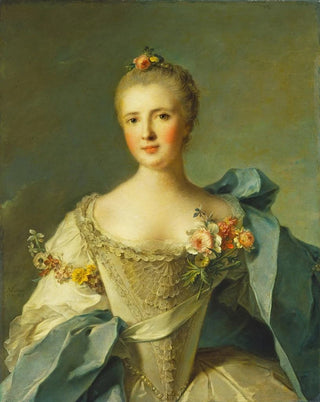Art print | The Marquise of Bélestat - Jean-Marc Nattier


View from behind

Frame (optional)
In the rich and varied landscape of 18th-century art, the art print "La marquise de Bélestat" by Jean-Marc Nattier stands out for its elegance and delicacy. This painting, which captures the beauty and refinement of its model, is a true homage to the aristocratic woman of the era. Nattier, a master of portraiture, manages to transcend simple representation to offer a vision imbued with grace and sophistication. The marquise, dressed in a sumptuous gown, seems to emerge from a dream, embodying both the beauty and power of a woman of her time. Through this art print, the viewer is invited to immerse themselves in a universe where light and color blend harmoniously, creating a living tableau that continues to fascinate entire generations.
Style and uniqueness of the art print
Nattier's style is characterized by meticulous attention to detail and a subtle use of light. In "La marquise de Bélestat," every element, from the drapery of the gown to the delicate accessories, is carefully crafted. The color palette chosen by the artist evokes a softness and luminosity that highlight the beauty of the subject. Pastel shades, combined with touches of gold, create an atmosphere that is both intimate and majestic. The marquise's posture, slightly tilted, as well as her captivating gaze, testify to a strong and charismatic personality. This portrait is not limited to a simple physical representation; it also reveals a psychological dimension, capturing the very essence of the marquise. The composition, balanced and harmonious, demonstrates Nattier's exceptional craftsmanship, who manages to combine realism and idealization, making each art print a true masterpiece.
The artist and his influence
Jean-Marc Nattier, born in 1685, established himself as one of the most prominent portraitists of his time. Trained in his father's workshop, himself a painter, Nattier quickly developed a distinctive style that allowed him to stand out in the Parisian artistic scene. His portraits, often commissioned by the aristocracy, reflect a deep understanding of psychology

Matte finish

View from behind

Frame (optional)
In the rich and varied landscape of 18th-century art, the art print "La marquise de Bélestat" by Jean-Marc Nattier stands out for its elegance and delicacy. This painting, which captures the beauty and refinement of its model, is a true homage to the aristocratic woman of the era. Nattier, a master of portraiture, manages to transcend simple representation to offer a vision imbued with grace and sophistication. The marquise, dressed in a sumptuous gown, seems to emerge from a dream, embodying both the beauty and power of a woman of her time. Through this art print, the viewer is invited to immerse themselves in a universe where light and color blend harmoniously, creating a living tableau that continues to fascinate entire generations.
Style and uniqueness of the art print
Nattier's style is characterized by meticulous attention to detail and a subtle use of light. In "La marquise de Bélestat," every element, from the drapery of the gown to the delicate accessories, is carefully crafted. The color palette chosen by the artist evokes a softness and luminosity that highlight the beauty of the subject. Pastel shades, combined with touches of gold, create an atmosphere that is both intimate and majestic. The marquise's posture, slightly tilted, as well as her captivating gaze, testify to a strong and charismatic personality. This portrait is not limited to a simple physical representation; it also reveals a psychological dimension, capturing the very essence of the marquise. The composition, balanced and harmonious, demonstrates Nattier's exceptional craftsmanship, who manages to combine realism and idealization, making each art print a true masterpiece.
The artist and his influence
Jean-Marc Nattier, born in 1685, established himself as one of the most prominent portraitists of his time. Trained in his father's workshop, himself a painter, Nattier quickly developed a distinctive style that allowed him to stand out in the Parisian artistic scene. His portraits, often commissioned by the aristocracy, reflect a deep understanding of psychology






